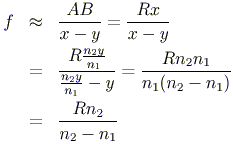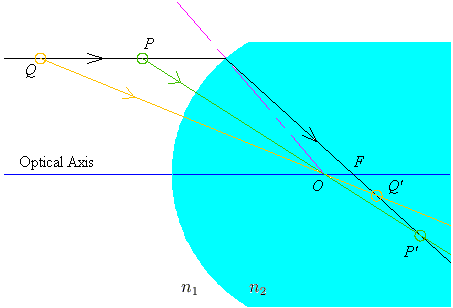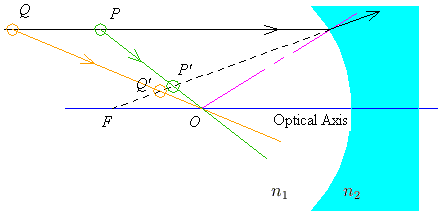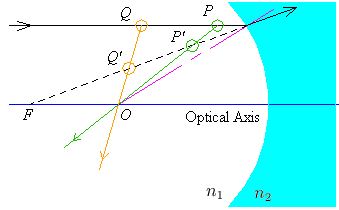Let consider the light at a spherical surface, and assume a traveling from the region of smaller refractive index to the region of higher refractive index, so that there is no possibility of total internal reflection. Consider a convex and circular body, having the center of curvature O and radius R, placed between two different regions.
If the light rays are coming from infinity and they are at a close distance to the optical axis, then the angles will be small, and approximation of the smaller angles is always a good sign. Assume, the x, y, and z angles that are labeled above are small enough to hold the approximation. When the light ray is hitting the point A, then according to the Snell’s law it is refracting. By keeping the simplified Snell’s law in the mind, the following situation can be stated.

For discussion of refraction, the ray-tracing technique can also be used while using the mirrors. Let consider a ray that is bent for intersecting the focus, and a light ray through the center of curvature, that is not bent. Observe, the given boundary in the image, for the next step.

The given image is shrunken and inverted and it is located in the second region. With the concave mirrors, the three cases can be observed with the concave refractive boundaries.
When the source is placed beyond the focus, then an upright and diminished image is obtained in front of the source, and it is located between the center of curvature, and focus.

The image should be between the center and focus, as by the traveling from low refractive index area to the high refractive index area, it is not possible by the refracted ray to bent past the normal line. When the source is between the center of curvature and focus than the image is again upright and diminished.

It is a must for the image to be located between the center and focus when placed in front of the source. In the final stage, the source could be located between the boundary and center. In this case, the image is upright and shrunken.

If the image is located between the center and boundary, then it also is behind the source. In the geometry, this an easy consequence, as the source is in front of the center, and the light ray that is going through the center, must have to go backward for intersecting the line, that is passing by the focus.